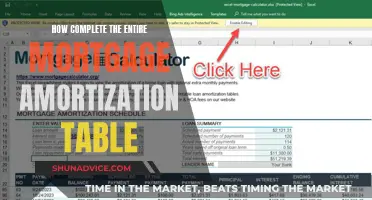
A silent second mortgage is a type of second mortgage placed on a home, bearing the name silent because it is hidden from the first lender. This secondary loan is not disclosed to the first mortgage lender, which can cause serious issues if the property goes into foreclosure. The danger here is that the first mortgage lender believes they have the first claim to the collateral in the event of default, but the presence of a silent second mortgage changes that. Silent second mortgages are illegal and can land borrowers in legal trouble. Borrowers can avoid silent second mortgages by applying for a down payment assistance (DPA) program.
| Characteristics | Values |
|---|---|
| Legality | Illegal and can lead to prosecution for mortgage fraud |
| Risk | Increases the risk of default |
| Interest | Often at a higher interest rate than a typical mortgage |
| Monthly payments | Two separate monthly payments |
| Equity | Takes longer to earn true equity in the home |
| Alternative | Down Payment Assistance (DPA) programs |
What You'll Learn
- Silent second mortgages are illegal if undisclosed to the original lender
- Down Payment Assistance (DPA) programs are a legal alternative to silent second mortgages
- DPA programs are funded by federal, state, local governments, non-profits, or private entities
- DPA programs may require home-buyer education courses to ensure understanding of responsibilities
- Silent second mortgages can distort the true value of properties and the level of risk in the market

Silent second mortgages are illegal if undisclosed to the original lender
A silent second mortgage is a type of second mortgage placed on a home, bearing the name "silent" because it is hidden from the first lender. It is considered a "silent" second mortgage if the loan is used to secure down payment funds and isn't disclosed to the original mortgage lender before closing. In this scenario, the buyer purchases the home with lent money, but it appears as though they are using their own money.
The presence of a silent second mortgage can significantly increase the risk of default. The home buyer is taking on more debt than the primary lender is aware of, which can violate the terms of the first mortgage. The primary lender determines the amount of money to lend based on the borrower's financial situation and the risk of default. By not disclosing the second mortgage, the borrower is misrepresenting the level of risk.
To avoid the risks and illegality of a silent second mortgage, borrowers can apply for a down payment assistance (DPA) program. These programs are funded and offered by government-sponsored agencies and non-profit organisations. They provide borrowers with access to soft second loans, which have extremely favourable terms, including low or zero interest rates, and are legal since the lender is aware of the situation.
Bush's Legacy: Lowering Mortgage Standards, Raising Risks
You may want to see also

Down Payment Assistance (DPA) programs are a legal alternative to silent second mortgages
A ""silent" second mortgage is a type of second mortgage placed on a home that is hidden from the original mortgage lender. This secondary loan is not disclosed to the first mortgage lender, which is illegal and can cause serious issues if the property goes into foreclosure. Silent second mortgages can also distort the true value of properties and the level of risk in the current market.
Another example of a DPA program is the Chenoa Fund Program, which provides down payment assistance of up to 3.5% of the home's purchase price. This can be used to cover the 3.5% down payment requirement of an FHA loan or the closing costs and 3% down payment requirement of a conventional loan.
DPA programs may also require participants to complete homebuyer education courses to ensure they fully understand the responsibilities of homeownership. By pairing a first-time home buyer program with down payment assistance, buyers can avoid the need for a silent second mortgage loan.
In addition to DPA programs, buyers can also explore other options such as home equity loans or Home Equity Lines of Credit (HELOCs) to help with the down payment. It is important for buyers to understand the risks and legal implications of taking out a second mortgage and to consider the impact on their financial health.
ARM Mortgages: Are They Still Popular?
You may want to see also

DPA programs are funded by federal, state, local governments, non-profits, or private entities
Down payment assistance (DPA) programs are designed to help potential home buyers overcome one of the most significant barriers to homeownership: the down payment. DPA programs are funded by federal, state, local governments, non-profits, or private entities.
DPA programs can provide thousands of dollars to eligible buyers and are typically designed for first-time home buyers. However, a repeat home buyer may still qualify as a "first-time buyer" if they haven't owned a home in the past three years. To be considered a first-time home buyer, you must not have owned a home in the past three years. Eligibility for DPA programs often hinges on income level, credit score, and sometimes the location of the home being purchased.
Some DPA programs offer grants that do not need to be repaid. Others provide zero-interest loans that are repayable upon the sale of the home or once the primary mortgage is paid off. There are also low-interest loans that require repayment on favourable terms. Some DPAs offer forgivable loans or cash gifts that don’t need to be repaid, while others may require low or no-interest repayment.
The ADFA Down Payment Assistance Program (DPA) is one example of a DPA program. Qualifying moderate-income borrowers can receive up to $15,000 to use for their down payment and closing costs. This 10-year loan works as a second mortgage, which you pay alongside your mortgage payment. The California Housing Finance Agency's (CalHFA) MyHome Assistance Program is another example, providing eligible Californians with up to 3.5% of their home purchase price towards a down payment.
In contrast to DPA programs, taking out a "silent" second mortgage to cover your down payment is illegal. A silent second mortgage is a type of second mortgage placed on a home, bearing the name "silent" because it is hidden from the first lender. This secondary loan is not disclosed to the first mortgage lender, which can cause serious issues if the property goes into foreclosure.
Mortgage Brokers: Surviving the Bubble Burst and Beyond
You may want to see also

DPA programs may require home-buyer education courses to ensure understanding of responsibilities
Down Payment Assistance (DPA) programs are designed to help potential home buyers overcome one of the most significant barriers to homeownership: the down payment. DPA programs can make monthly mortgage payments more manageable and cater to a variety of individuals, including first-time homebuyers, people with disabilities, veterans, and low-to-moderate-income families.
DPA programs may require home-buyer education courses to ensure that participants fully understand the responsibilities of homeownership. These courses can be completed in person or virtually and provide valuable information about the home-buying process, financial management, and homeownership responsibilities. They can also offer insights into the current trends, market conditions, and financing options available, empowering participants to make more informed decisions about their property searches and negotiations.
The content of these courses can vary, but some common topics include understanding the full cost of homeownership, managing maintenance costs, lease agreements, and complying with zoning regulations. These courses can also help participants navigate the various steps involved in the home-buying process, such as pre-approval, researching and applying for assistance, approval and assistance, purchasing the home, and complying with program requirements.
Completing a home-buyer education course may be a necessary step to qualify for certain DPA programs and grants. It is important to check the specific requirements of the DPA program you are interested in to ensure that the course you take meets their standards. These courses can often be found through local libraries or community centers, real estate agents, lenders, local banks, credit unions, or housing agencies.
The Mortgage Bond Market Crash of 2008: A Postmortem
You may want to see also

Silent second mortgages can distort the true value of properties and the level of risk in the market
Silent second mortgages are a type of second mortgage on a home that is hidden from the original lender. This means that the borrower does not disclose the existence of the secondary loan to the lender of the first mortgage. This can cause serious issues if the property goes into foreclosure, as the first mortgage lender believes they have the first claim to the collateral in the event of default, but the presence of a silent second mortgage changes that.
The use of silent second mortgages can distort the true value of properties and the level of risk in the market. This was evident in the lead-up to the 2008 financial crisis, where silent second mortgages and other risky lending practices contributed to a housing bubble. By taking out a silent second mortgage, buyers are taking on more debt than the primary lender is aware of, which can violate the terms of the first mortgage. This increases the risk of default, as the lender is now at a higher risk of losing the money they lent.
Additionally, the "silence" in a silent second mortgage refers to the absence of a payment burden imposed by the second mortgage. In some cases, the second mortgage may carry a zero or low-interest rate, or interest may be deferred for several years. The principal may not be repayable until the house is sold. This can create a misleading picture of the buyer's financial health and the true value of the property.
Furthermore, the use of silent second mortgages can also distort the level of risk in the market. Lenders use detailed formulas to determine how much mortgage payment a borrower can afford, taking into account the risk of default. By hiding the existence of a second mortgage, borrowers can misrepresent their financial situation and obtain a larger loan than they would otherwise be able to. This increases the risk for lenders and can contribute to a housing bubble if left unchecked.
In conclusion, silent second mortgages can distort the true value of properties and the level of risk in the market by creating a misleading picture of the buyer's financial health and the actual value of the property. This can have significant consequences for both the borrower and the lender, and it can also impact the overall stability of the housing market.
Monthly Mortgage: How Much Should You Be Spending?
You may want to see also
Frequently asked questions
A silent mortgage is a second mortgage on a home that is not disclosed to the lender of the first mortgage. It is used when a buyer cannot afford the down payment required by the first mortgage.
Silent mortgages are illegal because they are not disclosed to the original lender. This means that the original lender believes the down payment to be higher than it actually is, which increases the risk of the borrower defaulting.
There are several down payment assistance (DPA) programs available through local and state governments, as well as at the federal level. These programs provide grants or low-interest loans to help with the down payment on a home.







